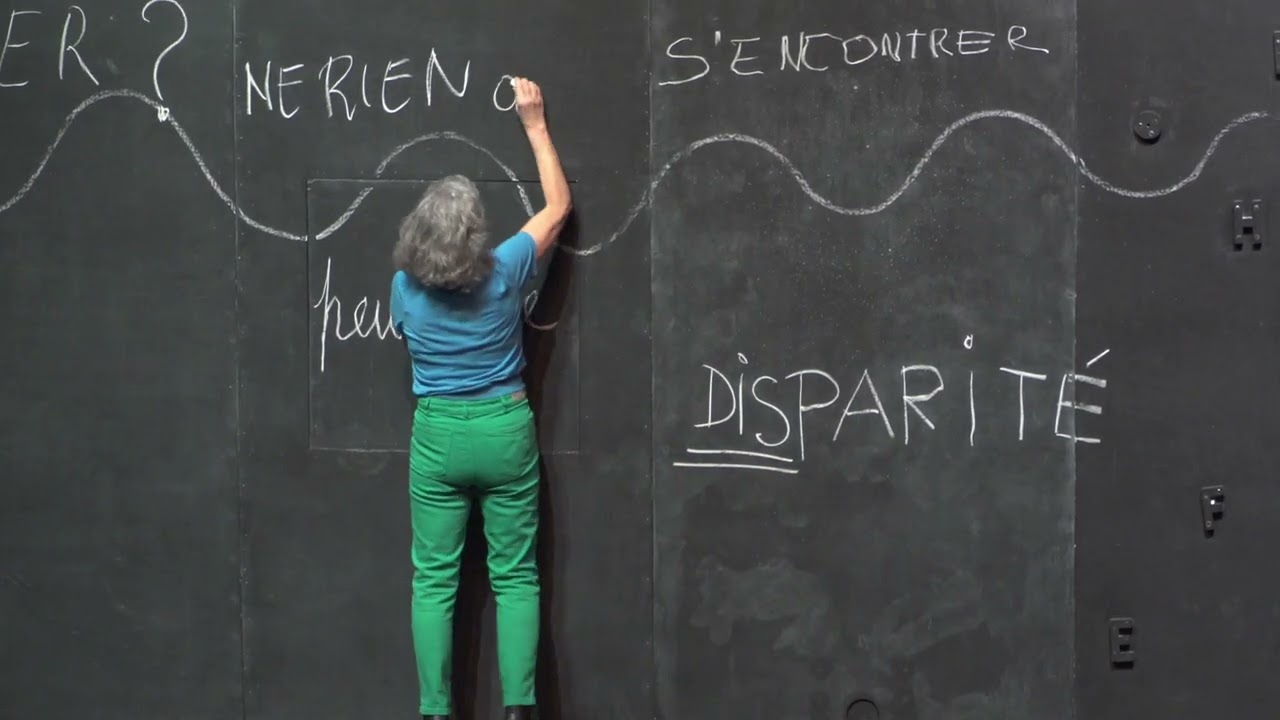Jean-Christophe Bleton’s Ne Lâchons rien (“Don’t let up”), was one of the featured pieces in the Faits d’Hiver 2024program. It is cap piece to an admirable and amusing dance performance trilogy called Bêtes de Scène (“Stage Warriors”), which turns around getting older while working in the performing arts. Admirable because it brings up most of the personal and professional issues associated with getting older as a question of how a body is looked at from inside and outside. Amusing because the cast is perfect at what it’s doing and how it’s doing it; the cast comes out, above all, as persons dealing with their challenges, not “ageing [actors, parents, dancers, etc, etc, …]”.
Bleton’s trilogy, put together over the past seven or eight years, includes Bêtes de Scène – masculin (2017) and Bêtes de Scène – feminin (2021) as well as Ne Lâchons rien. The average age of the cast(s) at the premier of the cap piece – including the seven women and seven men from the first two pieces – is 65. The youngest player is 54 and the oldest, 70. All are still working.
Bleton, who has led his dance troupe Cie Les Orpailleurs since founding it in 1990, is a student of the legendary dancer, choreographer and teacher Karin Waehner, knows something about keeping on keeping on – he’s been at it a bit over 50 years . He began dancing professionally in 1973 and then, in 1977, joined Carolyn Carlson on her innovative and ground-breaking contemporary dance project. As Bleton told me in an earlier interview (Cie Les Orpailleurs: practicing the dangerous art of thought in muscle & blood, skin and bone), he looks at aging and age through a meta-political lens, as a question of making democracy, which, he believes, comes to be when every person is included in identifying and deciding the things that concern them.
Bleton and I talked about Ne Lâchons rien and his Bêtes de Scène project during a break from rehearsal session at Centre National de la Danse (CND), earlier this year.
“I didn’t plan Bêtes de scène; it came about by chance,’ he tells me as soon as we were sat down.
“But when you think about it, it makes sense. When I began working on Bêtes de scène – masculin, I was past 50, getting toward 60. I should have already stopped working by that time. I was already past what is the norm.”
So Bleton did what a career performer and choreographer does when confronting his own ab-norm-ality: decided to make a performance about coming to grips with it.
“I told myself I needed to do the piece with my friends and sort of see where we all were at”. How old is too old? At what age should we stop dancing? Should the stopping point be a physical barrier? Or a mental or non-physical barrier?
Bleton’s dramatic inspiration, at least for the first piece of the trilogy, was Akiro Kurosawa’s iconic Seven Samurai(1954), in which, on a promise of rice and beans, seven people join together to save a village – in the same way that, for instance, seven old friends might accept to be cast in an upcoming performance in search of a story, financing and an audience. But there’s more. In addition to being an exotic and brilliant reflection on the sense in things in general, five of Kurosawa’s samurai are particular studies in facing the world as a body grows older, working alongside with, for contrast and cultural critique, a young disciple and an amateur or natural (however you want to frame it).
Bleton gathered a cast of long-time man friends and colleagues.
“We got Bêtes de scène – masculin done. Our women-friends came to see us. They said, ‘You should do one with us’”.
However, the request didn’t seem so straightforward to Bleton.
“I didn’t feel I could be legitimate talking about women’s experiences of life”.
And then, he says, “We were, we are, I am cis-gender heterosexuals” of a certain time and context. Which means, he continues, that neither he, his men performers or women performers ask themselves so much about what is “gendered” in them as about what is “feminine” or “masculine” in their personalities as men or women.
Bleton reflects, “I guess we question gender without questioning gender norms”.
The veteran choreographer resolved his legitimacy and relevancy dilemmas as he did more naturally in the man-version (where he was a member of the cast): by deciding to go ahead and let the women performers present themselves as they defined themselves. As in the man version, he asked the cast to build up a script that mirrored their experiences and their approaches to living and loving while getting older.
Bleton feels that in letting the women do their own take, he got “two pieces [that] are as different from each other as we feel women and men are from each other.”
Aging for the women of Bêtes de scène – feminin, Bleton says, “is a lot more about how they are looked at from the outside” and how they keep a handle on that; it is more political because physical evolution of the image is a greater part of “old” – the game is to fight being excluded. The men of Bêtes de scène – masculin, on the other hand, define “old” around “performance” – referenced as the innumerable health problems, small and large, that seem to assail a man body after 50. The challenge is not so much political or social as personal, a fight to stay relevant or included …
In each of the first two pieces and in the third, too, keywords, such as “Resist” or “Do again” or “Too much” referencing common, as well as particular – the particularities that struck me were “nephritic colitis” for the men and “insomnia” for the women – themes are chalked up on the walls of the set.
I have to say, as I talk with Bleton, I’m thinking that maybe men ought to consider more political and social action than they do. Remember Alex and his droogs beating the old tramp in Kubrick’s Clockwork Orange? Well, it’s not so much the stereotypes that underlie the representation of oldness in men, but the actual and pervasive de-consideration and de-empowerment that color in the stereotype. Even such notorious sociopaths as the enormously rich and powerful whiteman Rupert Murdoch are not immune from it. As a member of a privileged group, ageism, I think, has a sting that is much more felt and much more concealed. It is consolation to think Murdoch feels it in proportion to his wealth…
But I put these thoughts aside and say to Bleton, does Ne Lâchons rien propose a third gender, a uni-gender, where men and women meet?
“No,” he says, with emphasis.
“Ne Lâchons rien is a meeting of men and women and a meeting with love”.
“Our issue is ‘What is our relationship’ with one another now?
The first two pieces separate along gender lines, he says, but that’s deliberate and desired, “both are fundamentally optimistic” – full of “the will to change and evolve”, to be together now. Ne Lâchons rien brings together the men’s and women’s optimism and their common will to evolve. So, while Bêtes de scène – feminin and -masculin let their characters diverge and define felt differences, Ne Lâchons rien shows them accepting and living with those divergences and differences.
The choreographer and director closes our conversation with the observation that “oldness” is not so much a question of getting older as adapting to oneself. “We can live just fine right up to the edge of the end”, he says.
“You just need to listen to yourself. If you can’t move around, you can still listen and read. There is the moment in life where you can jump over the moon and a moment in life when the book falls out of your hand. Each of those moments is life …”
________
“Ne Lâchons rien” combines the casts from “Bêtes de scène – masculin” and “Bêtes de scène – feminin”. Choreographed by Jean Christophe Bleton, assisted by Marina Chojnowska, for the premier on 31 January 2024 at MAC Créteil the cast included Lluis Ayet, Odile Azagury, Yvon Bayer, Christian Bourigault, Annick Charlot, Jean-Philippe Costes-Muscat, Jean Gaudin, Vincent Kuentz, Huyen Manotte, Rachel Mateis, Gianfranco Poddighe, Carlotta Sagna, Sylvie Seidmann and Andrea Sitter.
Go to Source
Author: Paul Tracy DANISON

